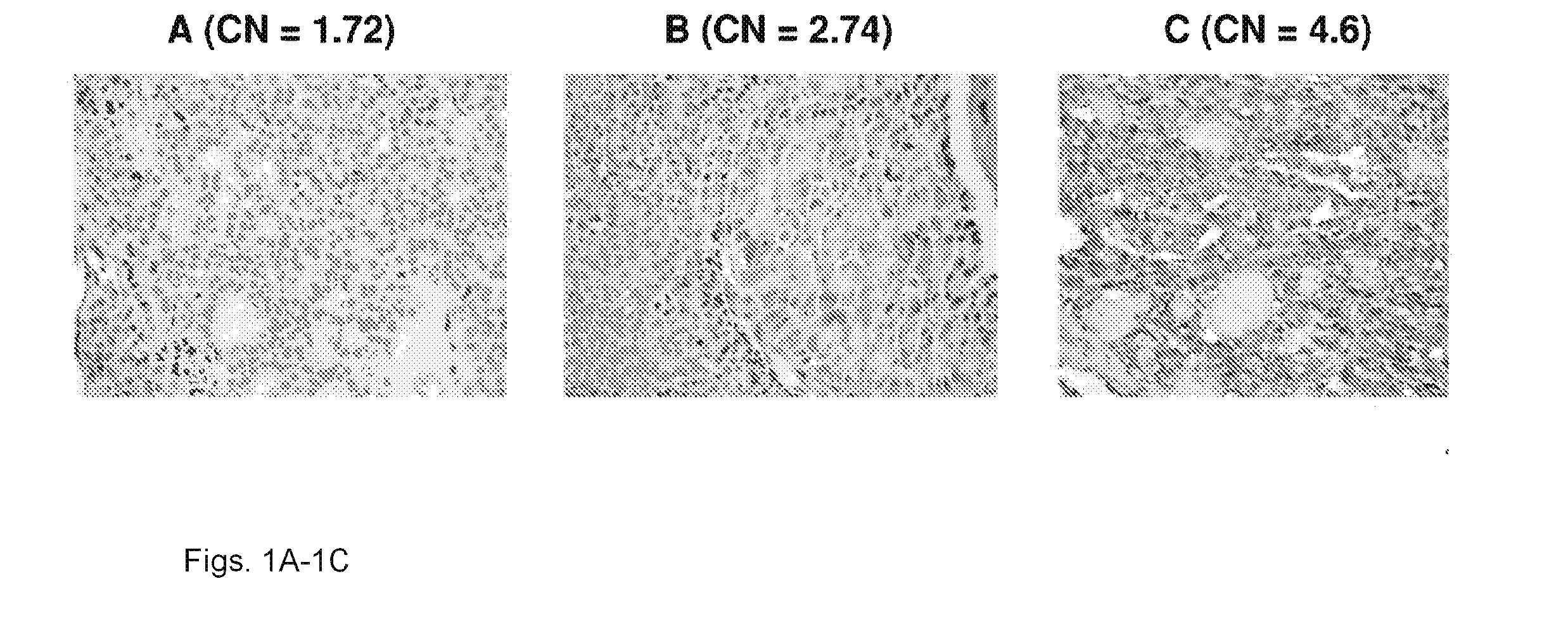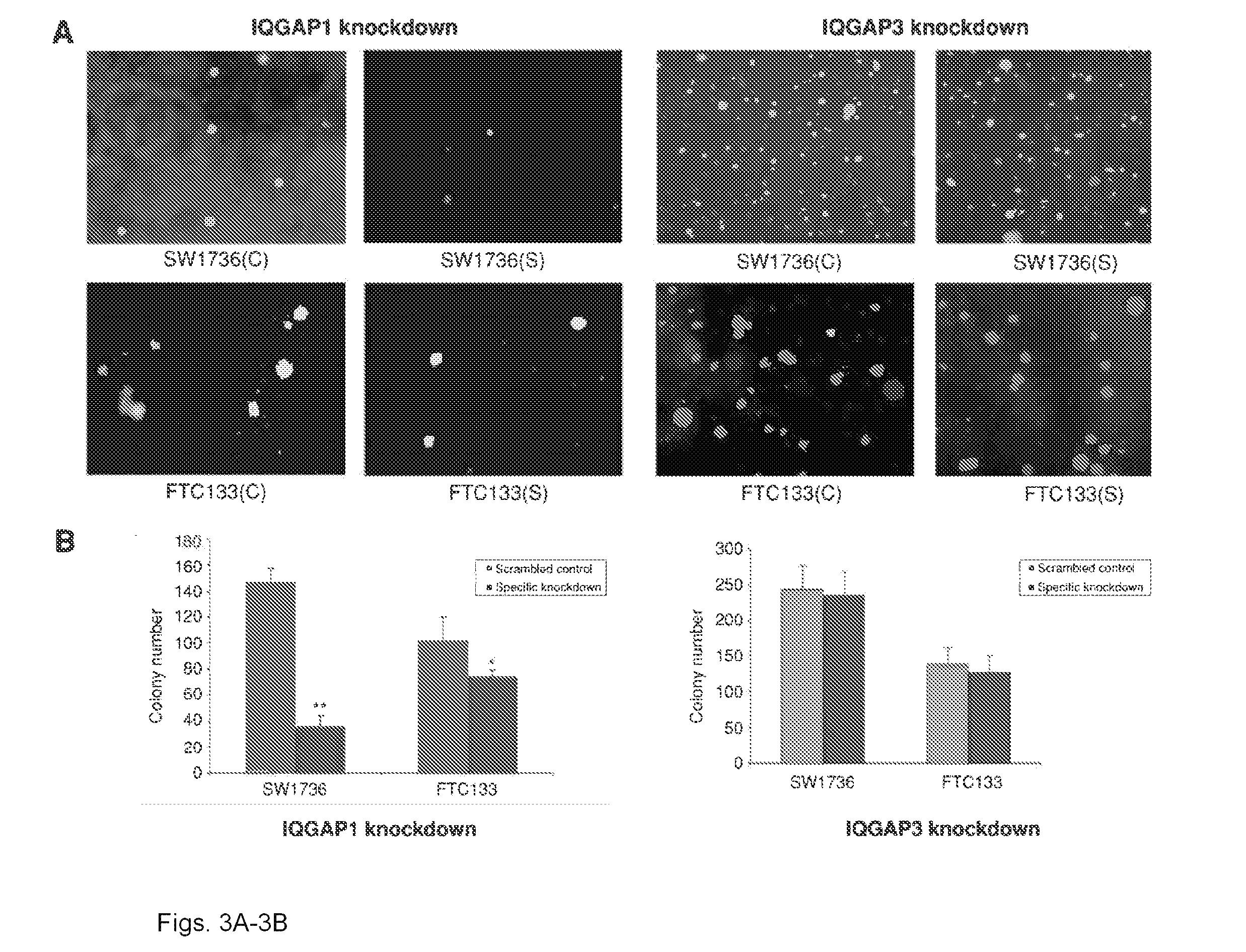Genetic amplification of iqgapi in cancer
- Summary
- Abstract
- Description
- Claims
- Application Information
AI Technical Summary
Benefits of technology
Problems solved by technology
Method used
Image
Examples
example 1
Materials and Methods
[0026]Genomic DNA Isolation from Thyroid Tumor Specimens
[0027]A total of 383 thyroid tumor samples were analyzed for this study, including 30 benign tumors, 205 PTC, 107 FTC, and 41 ATC, which were originally obtained and prepared for genomic DNA isolation with institutional review board approvals (23). In brief, after xylene treatment to remove paraffin, tissues were digested with sodium dodecyl sulfate-proteinase K and DNA was subsequently isolated following standard phenol-chloroform extraction and ethanol precipitation protocols.
Analysis of IQGAP1 Mutation in Thyroid Tumor Samples
[0028]Genomic DNA sequencing was done for IQGAP1 mutation analysis. We selected exons 19 to 23 and exon 29 for mutation analysis, as they constitute the IQ domain of IQGAP1 or sometimes harbored mutations in other cancers. Genomic DNA was amplified by PCR, using standard reaction conditions.
Analysis of Genomic Copy Gain of the IQGAP Genes with Quantitative Real-Time PCR
[0029]Quantit...
example 2
Uncommon Mutation but Common Genetic Copy Gain of the IQGAP1 Gene in Thyroid Cancers
[0040]A M1231I IQGAP1 mutation was occasionally seen in certain human cancers (29). We examined this mutation in 70 thyroid tumor samples but found only 1 case (1.4%) to harbor this mutation. We also examined exons 19 to 23, which constitute the functionally important IQ domain of IQGAP1, for possible mutation, and found no mutation in 70 thyroid tumor samples. Therefore, mutation of the IQGAP1 gene does not seem to be a major mechanism in thyroid cancer.
[0041]As tumor-promoting genes often gain CN in thyroid cancer (25), we analyzed IQGAP1 and IQGAP3 CN in various types of thyroid cancers. As shown in Table 1, IQGAP1 copy gain was common in thyroid cancers, seen in 66% and 41% of ATC and FTC, respectively, when the CN≧3 was used as the cutoff value. The highest copy gain rate was seen in ATC, followed by FTC, and PTC regardless of whether the cutoff value of CN≧3 or CN≧4 was used to define copy gain...
example 3
Association of IQGAP1 Copy Gain with Increased Expression of IQGAP1 Protein in Thyroid Cancers
[0042]To show the biological relevance of genetic copy gain of the IQGAP1 gene in thyroid cancer, we investigated the impact of this genetic alteration on the expression of IQGAP1 protein by IHS analysis using IQGAP1-specific antibodies on 29 FTC samples that had available histopathologic slides. FIG. 1 shows representative tumor samples illustrating the IHS scores and corresponding IQGAP1 CNs. Among the 9 cases without IQGAP1 copy gain (CN<3), 6 (66.7%) had a IHS score I, 2 (22.2%) had a score II, and 1 (11.1%) had a score III, whereas among the 20 cases with IQGAP1 copy gain (CN≧3), only 1 (5%) had a IHS score I, but 10 (50%) and 9 (45%) had cores II and III, respectively, with a significant difference between the 2 groups on overall analysis (P<0.01). To take a further look at specific groups, IHS score I was seen in 6 of 9 (66.7%) of the cases with CN<3 versus 1 of 20 (5%) of the cases ...
PUM
| Property | Measurement | Unit |
|---|---|---|
| Fraction | aaaaa | aaaaa |
| Fraction | aaaaa | aaaaa |
| Fraction | aaaaa | aaaaa |
Abstract
Description
Claims
Application Information
 Login to View More
Login to View More - R&D
- Intellectual Property
- Life Sciences
- Materials
- Tech Scout
- Unparalleled Data Quality
- Higher Quality Content
- 60% Fewer Hallucinations
Browse by: Latest US Patents, China's latest patents, Technical Efficacy Thesaurus, Application Domain, Technology Topic, Popular Technical Reports.
© 2025 PatSnap. All rights reserved.Legal|Privacy policy|Modern Slavery Act Transparency Statement|Sitemap|About US| Contact US: help@patsnap.com



